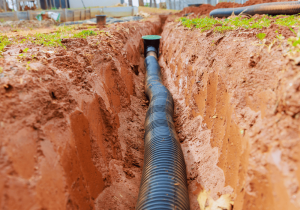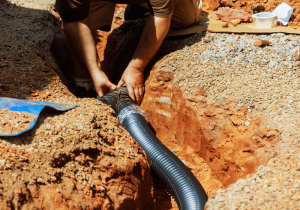Understanding Weeping Tile Systems and Their Role in Waterproofing

When it comes to keeping your home dry and protected, understanding your property’s drainage system is key. A critical yet often overlooked component of many waterproofing strategies is the weeping tile system. But what exactly is a weeping tile system? Why is it so integral to keeping your home safe from water damage? And how can you ensure it’s working efficiently?
This blog will break down everything you need to know about weeping tile systems—from their purpose to common problems and maintenance tips. Whether you’re a homeowner or someone exploring waterproofing options, this guide will provide clarity on an important system that safeguards your property from water infiltration.
 What Are Weeping Tiles?
What Are Weeping Tiles?
Weeping tiles, despite the name, aren’t tiles in the traditional sense. Rather, they are perforated pipes buried along the foundation of a home or building to manage water drainage. Historically, their name refers to how they “weep” or drain water away from the foundation to prevent water from settling around a building’s base.
These systems are typically installed at the footing of a foundation, resting in a trench that’s filled with gravel for improved filtration. Modern weeping tiles are usually made of plastic piping, and water enters through the small perforations in the pipe. Older systems, however, may consist of clay-based materials.
The water collected in the weeping tile is routed away from your foundation, typically to a storm sewer, sump pump, or another drainage system, where it can be properly discarded.
The Purpose of Weeping Tiles in Waterproofing
Weeping tile systems play a crucial role in keeping your home dry and your foundation protected. Here’s how they contribute to waterproofing efforts:
1. Redirect Water Away from the Foundation
Excess water around your foundation can lead to structural weaknesses, including cracks and leaks, creating long-term damage. Weeping tiles intercept water before it has a chance to collect and redirect it away to safe drainage points.
2. Prevent Basement Flooding
Homes without adequate drainage systems often face basement flooding, especially during heavy rainfall or spring thaw. Weeping tiles significantly reduce this risk by preventing water from entering your home in the first place.
3. Protect Structural Integrity
Water pooling around your home’s foundation exerts hydrostatic pressure, leading to cracks or weakened structural integrity over time. A properly installed weeping tile system reduces this pressure and keeps your foundation secure.
4. Enhance Indoor Air Quality
Persistent water leaks or dampness can encourage mould and mildew growth, compromising the air you breathe. By addressing excess moisture, weeping tiles can help protect you and your family from exposure to harmful allergens or toxins.
Common Problems with Weeping Tile Systems
While weeping tile systems are incredibly effective, they are not without flaws. Identifying potential issues early can save you from expensive repairs and prevent water damage to your home.
1. Clogging
One of the most common issues with weeping tiles is clogging. Over time, sediment, dirt, roots, or debris can accumulate in the pipe, reducing water flow and drainage effectiveness.
2. Improper Installation
If a weeping tile system is not installed correctly—for example, if the slope is off or if proper gravel backfill isn’t used—it may fail to efficiently guide water away from the home.
3. Aging or Damaged Systems
Older homes might have clay-based weeping systems, which can degrade over time or become prone to breakage. A damaged weeping tile will no longer provide effective drainage.
4. Freezing
For homes in colder climates, there’s a risk of freezing during harsh winters. Frozen water in the system can block water flow entirely or even lead to cracks in the pipe.
How to Maintain Your Weeping Tile System
To keep your weeping tile system running smoothly, regular inspection and maintenance are essential. Here’s how you can care for your system and address potential problems before they escalate:
 1. Conduct Regular Inspections
1. Conduct Regular Inspections
Periodically inspect your basement or foundation for signs of water infiltration, such as damp patches, cracks, or pooling water. These may be indicators of a malfunctioning weeping tile system.
2. Clear Debris and Sediment
Hire a professional to flush your weeping tile system if you suspect sediment, mud, or organic matter is clogging the pipes. A thorough cleaning can restore effective water flow.
3. Maintain Your Sump Pump
If your weeping tile system connects to a sump pump, ensure the pump is functioning correctly. Routine tests and cleaning of the pump are essential to keep it free of blockages.
4. Address Landscaping Issues
Ensure proper grading around your home so water doesn’t pool near your foundation. Avoid planting trees or shrubs too close to the foundation, as roots can interfere with the weeping tile system.
5. Consider a Camera Inspection
Modern diagnostic tools like camera inspections can identify blockages or damage in your weeping tile system without intrusive digging.
6. Upgrade Older Systems
If you live in an older home with clay weeping tiles, it might be time to upgrade to more durable, modern materials like plastic piping. This is particularly important if you’ve noticed frequent issues or are renovating your foundation.
Your home is one of your most significant investments, and protecting it from water damage is crucial. A properly functioning weeping tile system ensures your foundation remains secure, your basement stays dry, and your indoor air quality is safe. Whether you’re building a new home or maintaining an existing one, understanding the role of weeping tiles in waterproofing can give you peace of mind. Regular inspections, prompt repairs, and upgrades as needed can help extend the life of your system and prevent costly water damage.
If you’ve been neglecting your home’s drainage system or suspect your weeping tiles could use attention, now is the time to act. Reach out to a waterproofing specialist to ensure your system is working as efficiently as possible for years to come.
